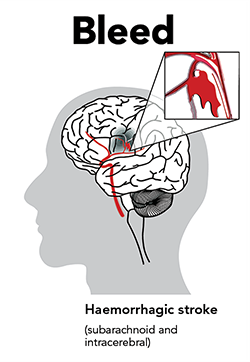Haemorrhagic stroke
A stroke can be caused by bleeding. This is called a haemorrhagic stroke (hemm-orr-ragic).
Blood can leak from a broken or burst blood vessel, which is one of the tubes or pipes that carry blood around the body. The leaking blood is like a bruise that injures part of the brain.

Blood vessels include arteries, which carry blood pumped from the heart to the rest of the body, and veins, which return blood to the heart.
There are two types of haemorrhagic stroke:
- Intracerebral haemorrhage (ICH) is when an artery inside the brain bursts and bleeds into the brain itself.
- Subarachnoid haemorrhage (SAH) is bleeding on the surface of the brain, between two of the layers of membranes that cover it.
High blood pressure
The main cause of haemorrhagic stroke is high blood pressure, or hypertension. The pressure breaks major arteries deep within the brain, causing an intracerebral haemorrhage.
Find out more about reducing high blood pressure.
Cerebral amyloid angiopathy (CAA)
When a protein called amyloid builds up in small blood vessels in the brain it is called cerebral amyloid angiopathy (CAA). The protein can damage the blood vessels and lead to bleeding (haemorrhagic stroke).
Sometimes the bleeding from CAA is very small and known as “microbleeds”. You might not know you have had microbleeds until they are picked up by brain imaging.
CAA is more common in older people and in people who have dementia. But sometimes it can run in families and affect people when they’re younger.
Blood-thinning medication
Medications that are taken to lower the risk of blood clots and ischaemic stroke can also make bleeding more likely. These medications are known as blood thinners, and may also be called anticoagulants or antiplatelets.
Your doctor will make sure you take the right amount of blood thinner to reduce your risk of both kinds of stroke.
Illegal drugs
Some illegal drugs such as amphetamine and cocaine can also increase the risk of haemorrhagic stroke by causing sudden severe rises in blood pressure.
Vascular malformations
When blood vessels don’t form properly they can become a vascular malformation.
A vascular malformation is usually present at birth. It may be that as you get older the blood vessels get bigger and weaker. It can occur anywhere in the body, including the brain.
An arteriovenous malformation (AVM) is an abnormal tangled connection between arteries and veins.
A cavernous malformation is a tangle of tiny blood vessels creating a weak-walled ‘cavern’ of blood.
If the vascular malformation is in the brain and the blood vessel walls burst, then you will have a haemorrhagic stroke.
Aneurysm
A weak or thin spot in the wall of an artery that balloons out is called an aneurysm. The aneurysm gets weaker as it gets bigger, and there is a risk it will burst and leak blood. Aneurysms often cause a subarachnoid haemorrhage.
Aneurysms develop over a number of years. Most people do not notice any problem until the aneurysm bursts. Controlling blood pressure and not smoking reduce the risk of aneurysm rupture.
More information
See Types of stroke on EnableMe.
If you or a loved one has had a stroke, there is support available. See our help after stroke section for more information.
